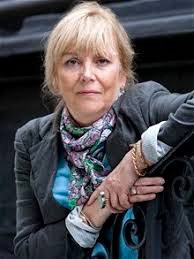Note: Kate Atkinson was WINNER of the Whitbread Book of the Year Award for her first novel, Behind the Scenes at the Museum (1995), and was twice WINNER of the Costa Award, its renamed successor, for Life After Life (2013) and A God in Ruins (2015).
“They weren’t stupid, they knew about trafficking, about people who tricked girls into thinking they were going to good jobs, proper jobs, who then ended up drugged, trapped in some filthy hole of a room having sex with one man after another, unable to get home again because their passports had been confiscated and they had to “earn” them back. [Anderson Price Associates] wasn’t like that. They had a professional website, all aboveboard.”

Kate Atkinson has rightfully developed a huge following with her impeccably crafted novels filled with ingenious plots, mysteries, and themes highlighted by unexpected ironies and dark humor. This, her twelfth novel, is the fifth in which she features Jackson Brodie, a detective who never seems to get his life together personally. Brodie has been hired by a wealthy wife to trail her golf-playing, country club husband, whom she believes to be having an affair. No matter what Brodie discovers or fails to discover, the wife wants him to continue trailing her husband. Unimportant in its own right, this plot thread ironically serves as a unifying idea for this book, with many bigger and more important plots and subplots, all of them unconnected until about a hundred pages into the book. At that point, several coincidences, obviously well planned, begin to create overlaps among the characters and their lives. As these are revealed, the reader discovers for the first time that the forty or so characters introduced in the first hundred pages here are not operating in a vacuum – except the vacuum deliberately created by Kate Atkinson to keep the reader guessing about what may happen in the still undeveloped subplots involving many undeveloped characters.
The book requires patience, well rewarded at the end. The first plot, and Atkinson’s whole approach, is exemplified by the ironies in the opening quotation, as two sisters from Poland, one of whom, Nadja, has a degree in Hospitality Management, contact Anderson Price Associates in London which employs three of the men who become main characters. Mark Price, a generic name for the company, tells these young women on the phone that the company will pay their way if they want to come to England to work and if they provide him with their papers. Nadja has been impressed at what she has seen on Skype when she has connected with Mark Price, who tells her he has something in mind “for a bright girl” like her. As she stares at the screen, she can see the Anderson Price logo on the wall, along with artwork, and an orchid, and hear the voices of the staff in the background, the tapping of keyboards, and ringing of phones. She never dreams that at the end of the call, Mark Price will lock up the mobile home where he is working alone and climb into his Land Rover, heading for home. “Mark Price was a fake….Only his Rolex was real.”

Whitby Abbey overlooks the town of Whitby, where the action takes place and where the author herself lived for a time.
A quick change of scenery introduces Jackson Brodie and his thirteen-year-old son Nathan, who is bored to tears at the reenactment of the Battle of the River Plate, a miniature naval battle at a local park. Nearby, at the Belvedere Golf Club, Thomas Holroyd, the owner of a haulage company; Andrew Bragg, a hotelier and travel agent; and Vincent Ives, a quiet man in the telecom business, whom the others consider an outsider, are on the green enjoying their day. Their marriages and current wives, their children, houses, and daily lives are depicted here in great detail, slowly and without excitement, all part of what appears to be Kate Atkinson’s overall plan to keep the reader ignorant of the real action, with characters floating around, and the plot lines undeveloped and unconnected long enough to increase suspense dramatically.
A hint of mystery occurs when Crystal, wife of golfer Tommy Holroyd, begins to panic because she believes that she is being followed by a man in a silver BMW. Then two more new characters are introduced. Reggie Chase, whom Jackson Brodie has known from the past, and her partner Ronnie Dibicki, both in their mid-twenties, are now working for the police on cold case files, and they eventually begin to discover strange activities which involve the “golfers” from the club. As they investigate further, the men’s activities enticing young girls into sexual slavery begin to become clear. By coincidence, Jackson, who has no connection to this investigation, sees a thirteen-year-old girl getting into a suspicious car on the street with an older man, but as Jackson is no longer in the police department, he has no one to report it to. In the meantime, the details of the domestic lives of all the characters, their wives, and their busy children, continue to unfold, and the direction of the novel begins to feel almost random, with a huge assortment of characters and actions which have yet to connect significantly. The character list continues to grow even longer, and the book seems to be getting heavier.

Whitby’s famed Whalebone Arch. Photo by Ron Jnr
At this point, it is crucial for readers to trust the intelligence and care for detail which Kate Atkinson has already proven in her previous novels. She has planned this book to the nth degree, and it does resolve itself completely and spectacularly by the end, however complex it feels in the long beginning. The shocking death of Wendy, almost ex-wife of the quiet Vince, the outsider of the golfing group, occurs shortly after the hundred-page mark. From that point on, the various subplots begin to overlap, often through coincidence, and then become increasingly intertwined. Additional deaths occur, the child pornography and the sex trade become a bigger part of the plotting, organized crime shows its hand, and the sleazy business of amusement parks and fairground activity involves some of the characters. As the action takes its twists and turns, the reader gradually becomes increasingly involved with the characters, and Atkinson’s grand plan begins to become clearer. By the end of the novel, every detail, every question, every conflict, and every unusual activity is resolved and explained.
Atkinson is such a creative writer that even the resolutions to some of these plot issues are not traditional or expected. It is here in the conclusion that Jackson Brodie not only shows his character and his sense of justice, but actively helps some of the subordinate characters to achieve justice of their own. By the time “The Fat Lady Sings” in the last chapter, many readers will be so energized by Kate Atkinson’s talent in drawing together the hundreds of details which feel so random in the beginning, that they, like the actor Bunny Hopps here, will be “soaring,” the “gods” will be laughing, the stars will be “twinkling like sequins,” and Atkinson’s many fans will be cheering.
ALSO by Kate Atkinson: CASE HISTORIES (Brodie #1), ONE GOOD TURN (Brodie #2), WHEN WILL THERE BE GOOD NEWS (Brodie #3), STARTED EARLY, TOOK MY DOG (Brodie #4) ,
LIFE AFTER LIFE, A GOD IN RUINS, TRANSCRIPTION
Photos. The author’s photo appears on https://www.telegraph.co.uk/
The history of Whitby Abbey, pictured here, may be found on https://www.english-heritage.org.uk/
The Cleveland Way trail is part of the national trail program in the UK: https://www.nationaltrail.co.uk/
This stunning photo of the Whalebone Arch in Whitby is by Ron Jnr and may also be found on https://www.trover.com
Crystal Holroyd, whose past is checkered, regards her Evoque car as a symbol of her changed life. https://auto.ndtv.com



